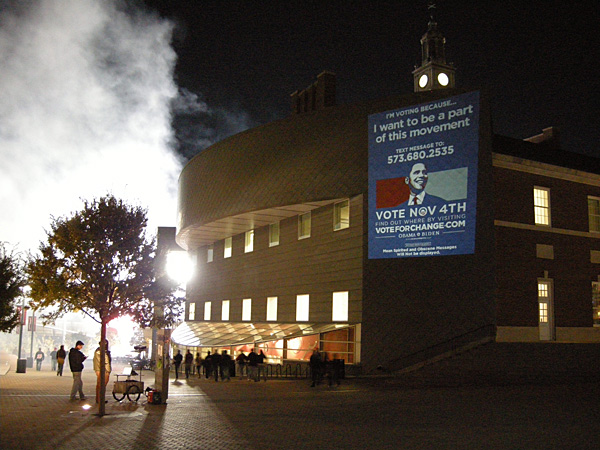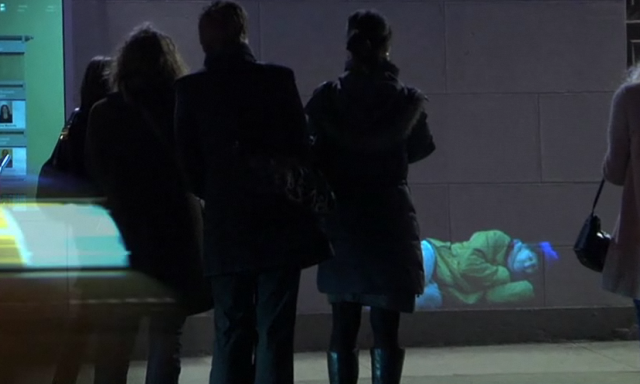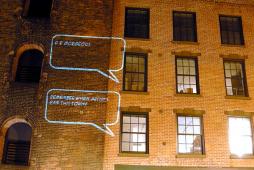Many lament that mobile phones can isolate us from our immediate surroundings as we walk down the street texting friends and not paying attention. These three different projects are encouraging people to actively engage with what's around them - with and on their mobile phones. TXTual Healing, Amphibious Architecture and Pathways to Housing take regular text messages and turn them into an interactive experience.
Txtual Healing
In 2006, Paul Notzold showed the first presentation of TXTual Healing as his MFA thesis project for Parsons School of Design. The project consisted of speech bubbles projected onto the side of a building; viewers texted in messages to fill the speech bubbles. Since then, the project has been shown around the world, including France, Italy, Romania, the USA, the Netherlands and China.
Notzold says that the inspiration for the project came from wanting to create a way to use the cell phone to draw people back into their surroundings. He explains, “I was really looking at the idea of creating narrative projects via the cell phone, and the idea that the simplicity of this object makes us so connected so easily to everything. But I also wanted to be critical about the cell phone pulling us out of our physical spaces.”
To pull users back into their physical space, Notzold either hands out slips of paper with a number to text or projects the number along with the rest of his show. Users text the number (a cell phone with a pre-paid SIM card), and the message is sent to a cell phone that is linked to a laptop. The texts are put into a queue and automatically projected onto the chosen surface (which can range from the side of a building, to movie screens, to ceilings; wherever the surface is flat enough and there is enough foot traffic to engage people). The portability of the device and the user-generated content makes each display different.
From the first showing, which had user-submitted texts appearing in speech bubbles positioned outside of windows, the program has grown to include still frame movies in which users can fill in the dialogue and change the frames, to raising voting awareness for the Obama campaign with a fill-in-the-blanks campaign that read “I’m voting because…” and let users finish the sentence, to using text messages to create temporary graffiti.

Notzold looks at the project as a means of not only using SMS for art, but also as a way of reconnecting people with their surroundings. He says, “From a socially active standpoint, it allows people to be big whether they’re saying very banal things or if they actually say very interesting things. They’re allowed to put their own feelings up on the wall into something that’s working with that environment – the speech bubble is working with the building as a stage to tell a story.” He continues, “In some ways, it’s very silly to write graffiti from your cell phone, but in another way it starts to connect the world of people that would walk around with cell phones and be sort of upset with graffiti, and they’re now connecting with the idea of writing on a wall – but in a way that isn’t permanent, and lets you walk away from it.”
The projections are usually unfiltered (unless he is asked in advance to filter the content at a private show), and he says that the anonymous nature of the show has led to some interesting moments. While he says he is disappointed that there are sometimes racist or sexist messages that get texted through, he understands that people want to test the system for its limits. In spite of these negatives, Notzold says that the unfiltered system has led to some very positive experiences; in China, he found that young couples were willing to express their personal feelings more freely through text messages than the would in person, and that some people chose to text lines from subversive poetry as their contribution to the show. At a show in Brooklyn when the police came due to the large crowd that had gathered, many people used the text bubbles to thank the police for letting them assemble and not shutting down the show in response to one user who sent in an anti-police message. Notzold notes that although people want to test the system, creating a platform for free speech has been a positive experience.
He says, “I was looking at really wanting to break down that fourth wall in theater, and allowing the audience to have a stronger voice in what they’re watching, or to make what they’re watching. A collection of what they want to see happen, and how that would all come together to create the performance that they’re watching – for better or for worse. […] The mobility of the cell phone took me out into the streets, where I could project.”
Amphibious Architecture
Last fall, the Living Architecture Lab at the Columbia Graduate School of Architecture, Planning and Preservation teamed up with the xClinic Environmental Health Clinic at New York University to launch Amphibious Architecture. The program allowed users to text message a number for information about the water quality of the East and Bronx Rivers and interact with the wildlife in those habitats. The following description, from the Amphibious Architecture website, explains the relationship between human interaction and the environment:
Installed at two sites along the East and the Bronx Rivers, this project is a network of floating interactive buoys housing a range of sensors below water and an array of light emitting diodes (LEDs) above water. The sensors monitor water quality, the presence of fish, and human interest in the river’s ecosystem, while the lights respond to the sensors, creating feedback loops between humans, fish in their shared environment. Additionally an SMS interface allows homo-citizens to text-message the fish and receive real-time information about the river, contributing towards the collective display of human interest in the aquatic environment. The aim of which is to simultaneously spark a larger public interest and dialogue about our local waterways.
Distinctly moving away from the pervasive ‘do-not-disturb’ approach to urban environmentalism, the project encourages curiosity and engagement.
This project encouraged participants to text one of eight codes (TommyCod, Alewife, ExtraAnchovy, eRiverBeaver, DearFlounder, WassupScup, CountBassie, DearTerrapin) to 41411 in order to receive updates on the water quality and animal population numbers. The buoys lit up both when animals swam by and when humans sent an SMS to the program. In this way, the interaction was two-fold: texters got an update about water quality and aquatic animal populations, and viewers passing the floating displays saw visual proof of interest in the rivers.
Pathways to Housing
 On a few cold evenings in early March, passers-by in lower Manhattan came upon a video projection of a sleeping homeless man. On the wall next to his form was a call to action: Send an SMS and get him off the street. Viewers who responded saw the projection change – the shivering homeless man got up and walked through a projected door, and they were then asked to donate $5 by following a second prompt.
On a few cold evenings in early March, passers-by in lower Manhattan came upon a video projection of a sleeping homeless man. On the wall next to his form was a call to action: Send an SMS and get him off the street. Viewers who responded saw the projection change – the shivering homeless man got up and walked through a projected door, and they were then asked to donate $5 by following a second prompt.
During the three days that the project ran, the projectionists estimated that between 800 and 1000 people stopped and interacted with the projection, and that more than 30 opted to continue on and donate via SMS.
The project was a way of drawing attention to Pathways to Housing, a non-profit that focuses on a housing-first solution to homelessness. Sam Tsemberis, who founded Pathways to Housing in 1992, explains the mission as, “The old thought was on treatment first before going into housing, but many homeless people fail readiness programs. For many people on the street, housing is the priority.”
To combat this losing situation, Pathways to Housing focuses on providing housing to the homeless so that they have a stabile influence in their lives before they begin tackle other problems like treating mental illness or substance abuse. The program focuses on moving homeless men and women into housing; once in stable housing, they are expected to pay rent and hold regular meetings with Pathways to Housing workers to help them keep on track.
The projection, created pro-bono by the design firm Sarkissian Mason, was a way of launching and promoting Pathways to Housing’s new online presence. Marcia Santoni, Chief-of-External-Affairs at Pathways to Housing, and Tsemberis credit Sarkissian Mason with coming up with the idea to create a phone-based, interactive campaign. Says Santoni, “It’s a one-time thing due to cost, but it has a virtual life long after.” The video of the project has been viewed over 8000 times online, and increased traffic to the Pathways to Housing website by 268%.
The campaign launched as part of a plan to draw attention to Pathways to Housing’s unique approach as the organization expands to a larger scale (it currently runs in New York, Washington, D.C., and Pennsylvania, but is expanding to a national scale). Currently, the bulk of the organization’s funding comes from government services, but as the program goes national, they are looking to diversify their funding through private donations. As such, they are building up their online and social media presence. After the projection campaign, the group saw a 68% increase in Facebook fans.
The projectionists chose their display locations carefully; since they only planned to show the projections for three nights, they needed to find high-traffic Manhattan locations with media-savvy pedestrians. They choose locations in lower Manhattan in order to target a younger demographic. Explains Santoni, “We wanted to put it in a place to maximize the number of people we could reach with the message.”
The combination of the projection with text messages forced passers-by to interact with the video. It was eye-catching, and the SMS element made participation easy for those who wished to interact with the video. Says Tsemberis, “It’s been a huge success in the amount of press and international attention.”
What Does It All Mean?
All of these projects offer ways for programs to gain attention and publicity, whether it’s for art, the environment or social awareness. The interactive element of text messages provides a memorable experience, while being quick and low-cost for the participant. As these three projects show, interactive SMS technology is not only eye-catching, it’s also catching on.
Anne-Ryan Heatwole is a writer for MobileActive.org
Image courtesy TXTual Healing
| Interactive Texts Involve You in Public Spaces data sheet 8111 Views | |
|---|---|
| Countries: | United States |

application to libraries
Public libraries could adapt these ideas to encourage more interaction with the physical spaces of libraries, and to create conversations between libraries and library users, and amongst library users. Great way to build community / encourage public discourse.
Post new comment